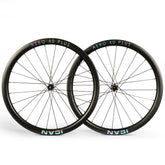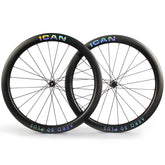How to do a road bike fit
You just bought a road bike on the internet and everyone tells you that you need a proper adjustment. The problem is that you don't have enough money to have a professional adjustment done. Well, we are going to give you some guidance and help. It is important to note that if you have physical injuries and are worried about making them worse, you should seek professional advice. You should see your physiotherapist or doctor and get the professional advice you need. The second point is that bike fittings are all about parameters.
This is more important for racing bikes than for other types of bikes. The reason for this is that on a road bike you tend to spend a long time in one position, whereas this is not the case with other forms of cycling. You'll also be riding at a high cadence, meaning your body will quickly tell you if you're doing your knee extension incorrectly.
Always listen to your body, it will always be able to guide you in your bike adjustment. There's an old rule that says knee pain at the back of your leg means the saddle is too high. If the pain is in the front, your saddle is too low. However, this idea is just a rule of thumb. However, one of the most common fitting mistakes is that many road cyclists have their saddle too high, perhaps because they want to look like the pros with their high seat posts.
Bike fit angle
It's about getting your body into a safe set of angles, angles that biomechanically work well for your joints. There is no right or wrong angle. In fact, the angles of your bike fitting can change over the course of a week. If you've spent the entire week at your desk from nine to five, you can't expect your body to contort into a cyclist's position as if you've been cycling all week.
Your bike fit will change over time. As you get fitter or actually stop exercising, it will change. It will change if you just ride the bike and your body adapts to it. It will change if you trip over something and get a slightly stiffer back. This means you can use a bike fitment you got last year as a base, but note that parts may have changed.
The easiest way to do a bike fit at home is with an app and a trainer. There is an iOS app called Bike Fit Fast. It does a great job, but they don't want to develop an Android version. Hopefully you have an iOS device or access to it. The other thing you'll want is colored sticky dots that you can then put in the right place to get good accuracy with the app.
Road bike pedals
After setting all of this up, be honest with yourself. The worst thing you can try is to force yourself into a racing position when your body can't hold it. This won't be a quick position. A more comfortable position will always be a faster position for the majority of people, mainly because you want to ride your bike.
A good first step is to look at your feet. You'll want to set your cleats correctly, or we'll start from an imperfect starting point when looking at you on the bike. One thing to remember is that cleats and pedals provide wiggle room. Slack is the amount of rotation from the center that the cleats will allow. If you have knee pain, more wiggle room is better. It allows your body to correct minor mistakes. Zero wiggle room doesn't do this, and you'll want a doctor to adjust your cleats correctly.
The reason leeway is good is because the knee not only moves up and down, but also twists during the pedal stroke. This then affects the rotation and pronation of the foot/ankle. When you have zero degree cleats, you massively reduce the amount of movement your body has to make to make this possible. You will tend to see more knee problems in people with zero degree cleats than those with wiggle room.
The general rule for front/back adjustment for your cleats is to take the first metatarsal and the fifth metatarsal, the first bony prominence on the outside of the foot, and align the pedal axle so that it bisects these two points. You can then adjust from this position. Remember that a forward position on the cleat causes more up and down movement in the heel. A forward position can then cause problems with the Achilles tendon. A rearward cleat position helps distribute pressure more easily when pedaling. Placing your cleats here can help with forefoot discomfort. Triathletes also prefer it as it is helpful when getting off the bike and running a marathon.
Besides all this, you want to check yourself in the mirror as you walk. This allows us to get your cleats in order. When you go toe forward, you should adjust your cleats to mimic this on the bike. If you walk toes out/heels in, you need to adjust the cleats to mimic this and also make sure the heel doesn't catch on the cranks if it falls down. As you walk inward, you need to let your heels point slightly outward.
Now you have an idea of your cleat positioning, it's a matter of optimizing some degree parameters for the rest of your position. Bike Fit Fast will be quick and easy to do and is easier than getting help from friends with goniometers. The cheat sheets are:
Hip angle - 55-70°
Elbow angle - 150-160°
Knee joint angle - 35-40°
Saddle height on a racing bike
To begin this process, you should set your saddle height correctly. Over the years I have found Greg Lemond's method to be a great starting point for your customization.
For this you will need a book and a tape measure. Stand flat against a wall. Place a book between your legs so that it might cause discomfort if you went further up. Let the tape measure hang from the book to the floor and measure the distance. It might be easier if someone helps you. I would also measure in centimeters.

Then take that measurement and multiply it by 0.883. Use this number to set your saddle at this height, measured from the center of your bottom bracket. You will then want to subtract 3mm for cycling shoes and cleats. The position should mean that when your pedals and cranks are at the bottom of your pedal stroke, the angle of your knee is 35 to 40°.
How to know if the angle is right for you
A quick tip to figure out if this angle is right: Sit on your bike with your pedals at approximately the 3 and 9 o'clock positions, your legs hanging freely. Check them out or take a video or photo with your phone. Look at your legs, this is the position they naturally want to be in. They will be a little weird. They won't be completely straight. They should look the same when clipped into your pedals.
If the position feels wrong to you, move it up and down in small increments until you feel completely satisfied. Don't stay in the same position if it causes you pain.





